Text
Glossary
Pedagogy: the method and practice of teaching, especially as an academic subject or theoretical concept.
Unequivocally: in a way that leaves no doubt.
Diligently: in a way that shows care and conscientiousness in one’s work or duties.
Syntactic: of or according to syntax; the arrangement of words and phrases to create well-formed sentences in a language / the structure of statements in a computer language.
Analogous: comparable in certain respects, typically in a way which makes clearer the nature of the things compared.
Ethnology: the study of the characteristics of different peoples and the differences and relationships between them.
Substratum: a foundation or basis of something.
Patently: clearly; without doubt.
Obliquely: not in a direct way; indirectly.
Anarchism: belief in the abolition of all government and the organization of society on a voluntary, cooperative basis without recourse to force or compulsion.
Unambiguously: in a manner that is not open to more than one interpretation.
Affiliation: the state or process of affiliating or being affiliated.
Constituting: be (a part) of a whole.
Temporality: the state of existing within or having some relationship with time.
Arbitrary: based on random choice or personal whim, rather than any reason or system.
Tyrannical: exercising power in a cruel or arbitrary way.
Tenuous: very weak or slight / very slender or fine; insubstantial.
Epidermis: the surface epithelium of the skin, overlying the dermis.
Ubiquitous: present, appearing, or found everywhere.
Panopticon: a circular prison with cells arranged around a central well, from which prisoners could at all times be observed.
Autonomous: (of a country or region) having the freedom to govern itself or control its own affairs / (in Kantian moral philosophy) acting in accordance with one's moral duty rather than one's desires.
0 notes
Text
Participatory Culture
I believe the fifth phase of participatory culture relevant to the internet from 2012 to present day, particularly through the use of social media, relates to the presentation and representation of self, whether realistic or falsified. Social media sites such as Facebook and Instagram allow us to create a filtered stream of the highlights of our life, and enable us to become versions of ourselves that we may wish to be, but actually are not.
Social media has demonstrated its ability to create insecurities among its users for a long time, which members of society comparing their own lives to that of others that they see on the sites. It has been criticised for being the cause, or at least an influence on the decrease in mental health of some of its users, particularly among the younger generations. Some users become dependent on their devices and the platforms for satisfaction, and in some cases can even go as far as addiction to them.
In a way, while connecting us to a multitude of people, including friends and family, it has a way of disconnecting us from reality, and rather steers our attention to a virtual reality that doesn’t actually exist. Creating an unhealthy perception of the world around us, social media and the internet have changed the way we live our lives and will continue to influence our minds in the years and developments to come.
0 notes
Text
Making Histories: 10 Practitioners
STEVEN MEISEL
Steven Meisel has been my favourite fashion photographer for a long time. I have always admired the work he produces and been inspired by the controversy he creates, some of which have been banned because of this. I think the messages that he conveys within his photography are really hard hitting and important, because they discuss certain issues within society and the fashion industry that can sometimes be overlooked or dismissed, as well as ones that are part of a bigger discussion that are discussed more nowadays. Meisel is an extremely influential photographer and someone who inspires me greatly, and explores subjects that I have interests in such as gender, the human form, sex and celebrities.
VIVIENNE WESTWOOD
Vivienne Westwood brings a sense of her personality through into her work, which is something I really admire as it makes her work more personal. She also gives a lot of purpose to her creations, with a lot of agendas relating to politics, the environment, ethical fashion and more. Westwood upholds a lot of very strong and important beliefs and values, which I believe is important to have as a creative as it can influence your work in positive ways. She also displays representation of minorities within her work, e.g. queer culture and ethnic minorities which is something I also admire.
NAN GOLDIN
Nan Goldin’s photography has always interested me because of how raw and personal it is. She is extremely open with her audience and documents intimate and dark parts of her life, such as domestic abuse and drug addiction, which I think is important in being able to inspire people to be more open when struggling. Goldin produced a lot of works representing queer culture, particularly drag queens she was friends with in New York City, and the crisis of the AIDS epidemic. She has a wonderful way of making you feel connected to her through her photography. That and her pure honesty is something I really admire.
LEIGH BOWERY
Leigh Bowery is one of my most fascinating practitioners. Another extremely controversial and innovative artist, he creates interesting and outlandish looks which are colourful and creative, and he has a certain appeal to his character that is somewhat charming and makes you intrigued. His work demonstrates a lot of focus on queer culture, reflecting on aspects of his personal life, as well as struggling through the AIDS crisis, which was the cause of his death. A lot of his work also relates to drag and drag culture which is an interest of mine, and he seems to take it one step further, creating looks that can sometimes appear unusual and somewhat uncomfortable to look at.
TRACEY EMIN
Tracey Emin creates her work from a personal perspective, exhibiting very honest and open sordid details of her life with her audience. She is similar to Nan Goldin in the way that they create connections with their audiences by being so open with them. I’ve always been interested in the details and secrets of other people’s lives, so Emin was the perfect artist for me to look at. She works with a lot of different mediums which makes her work more interesting, and has created some interesting concepts such as the ‘My Bed’ installation, which is a particular favourite of mine. I find her ability to turn dark moments of her life into art very admirable.
DAVID LACHAPELLE
David LaChapelle is an American photographer and video artist, who creates works that I believe to be extremely innovative and creative, and his intense use of colour and dreamlike scenarios are really interesting to me. His work reminds me somewhat of that of Tim Walkers, with more of a pop art twist, while also including elements of surrealism. LaChapelle focuses a lot on pop culture, which is another interest of mine and another reason I like his work.
PETRA COLLINS
Petra Collins has a predominantly feminist stance within her work. She has a lot of teenage subjects within her photography, and doesn’t choose models based on stereotypical ideals of beauty, which makes her work that little bit more interesting and I appreciate the ideals she presents in her work. Her photography techniques are very aesthetically pleasing, and I really enjoy her use of colour. Collins captures beautiful portraits of her female subjects and also conveys a lot of emotion within the images, while displaying an immense appreciation of the female form and its beauty.
BARBARA KRUGER
Barbara Kruger’s work comes from a more political perspective. Mainly consisting of short declarative statements, her imagery is very hard hitting, and makes you think about the issues she is discussing within the piece. She focuses a lot of gender, the economy, politics and culture, which are all subjects of interest for me personally which is one of the reasons I was drawn to her. I really enjoy the aesthetics of Kruger’s pieces too, and she also displays a type of signature, with the black and white photography behind the statements in white with red stripes.
GUY BOURDIN
Guy Bourdin appears to have a particular interest in the female form, and creates somewhat provocative imagery, which is what drew me to his work in the first place. “While conventional fashion images make beauty and clothing their central elements, Bourdin’s photographs offer a radical alternative.” Bourdin incorporates elements of surrealism in some of his images which is also one of the reasons I looked at his work as I enjoy photography that makes you question what you’re looking at, and the way he plays with the female form in his work is different to approaches that I have seen before.
TIM WALKER
Tim Walker’s photography comes across as incredibly innovative, and has been an interest of mine for a long time. Tim creates wonderous set designs, and brings to life fantasy childlike worlds within his shoots which makes his work really interesting to witness. It’s his creativity that really drew me to his photography and his work is really inspiring. Filled with colour and life, Walker plays with proportion to create scenes based on imagination. He also seems to have a personal and recognisable style, acting as a kind of signature, which is interesting to me as I haven’t seen this as much with other practitioners, but it is very prominent with Walker’s work.
0 notes
Photo
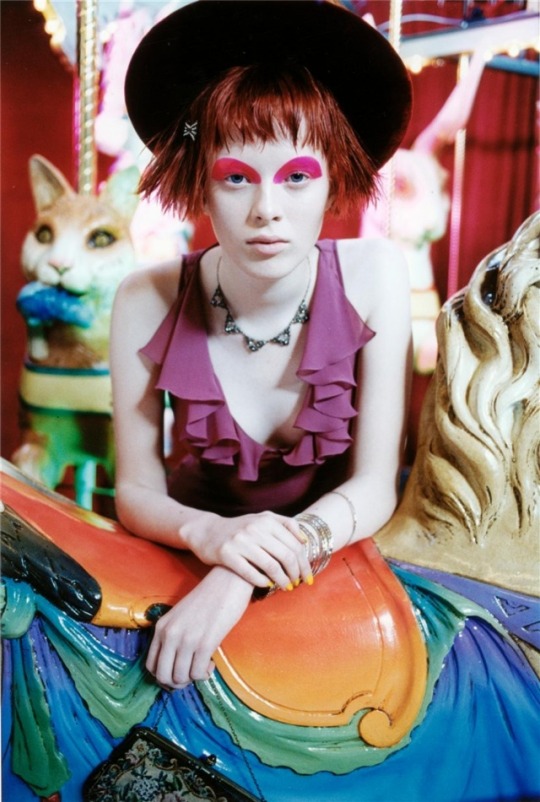
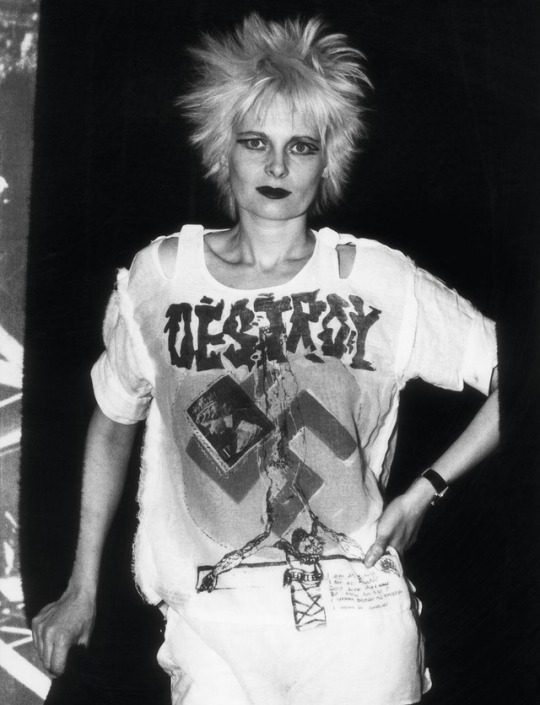
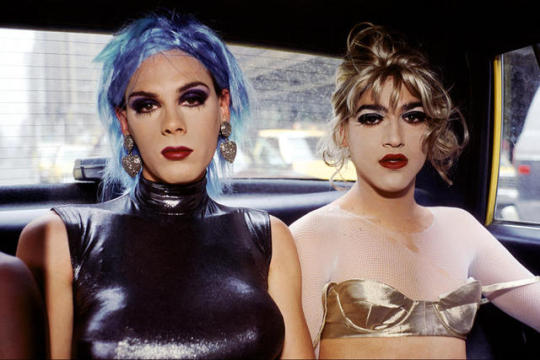

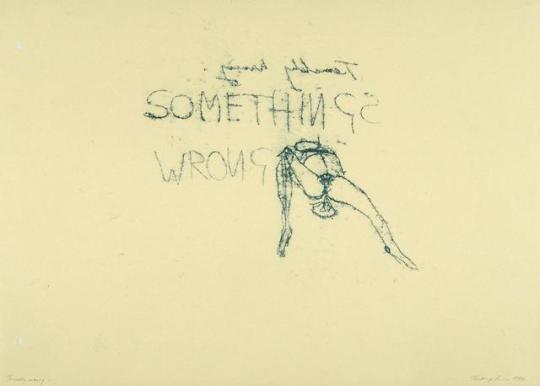




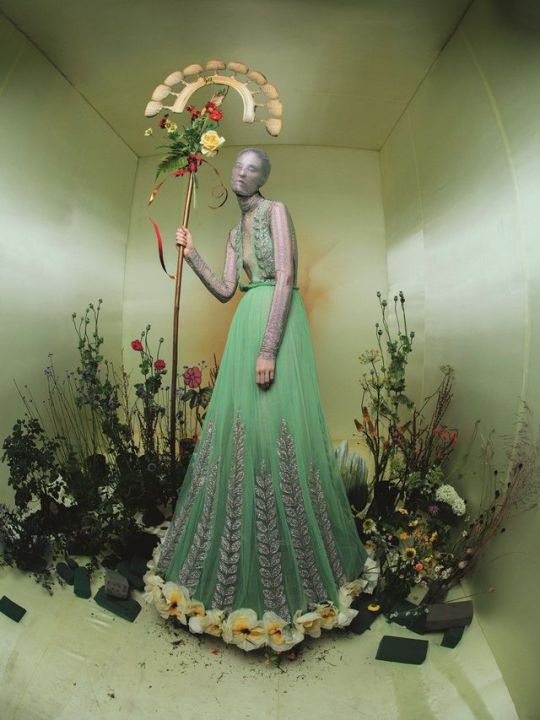
Steven Meisel, Vivienne Westwood, Nan Goldin, Leigh Bowery, Tracey Emin, David LaChapelle, Petra Collins, Barbara Kruger, Guy Bourdin, Tim Walker
0 notes
Text
Questioning Visual Materials: Steven Meisel
Controversy – Meisel has been noted as one of the most controversial fashion photographers, and has even had some of his advertisements/shoots banned in certain countries for their controversial themes and inflammatory imagery.
High-end Fashion – Meisel has exclusively shot every Italian Vogue cover for the last two decades and every Prada campaign since 2004, and works alongside a lot of other high-end brands
Provocative – Meisel’s work is that of a thought-provoking nature, as he wants the viewer of his photography to think about the messages he is trying to get across
Making a Statement – Steven produces work that makes a statement about something, whether it be political or societal, etc, and has been quoted saying ‘they say a little more than just a beautiful woman in a beautiful dress. I love that too, but to try and say something is also my goal”
Women – Meisel’s love of women comes across obviously in his photography, and he captures their beauty in many different lights
0 notes
Text
Christmas Task
Essay 1
There are a few elements of symbolism within the Great Gatsby both in the film and book.
The first and perhaps most important symbol within the film is the green light that shines from Daisy Buchanan’s dock, opposite the bay from Gatsby’s mansion. Initially, the green light represents Gatsby’s desire to win back Daisy, and is an example of an indexical sign, as it relies on further knowledge, in this case of Gatsby and Daisy’s relationship. The green light is also representational of the distance between Gatsby and Daisy, both physically in West and East Egg and emotionally.
As the film carries on and Gatsby’s desire for Daisy appears to grow stronger but seem more impossible to fulfil, the light symbolises an even deeper desire. Nick is seen to be in awe of Gatsby’s somewhat delusional sense of hopefulness for the unattainable thing that he desires.
The Valley of Ashes is another example of symbolism, relating to the representation of poverty and the overindulgence of the wealthy concerned only with their own fulfilment. It is situated between East Egg and West Egg, where Gatsby and Daisy live among other extremely wealthy members of society, and acts as a wasteland for the ashes and waste of the rich. This is also an example of an iconic sign, and the ‘thing’ (the valley), looks like what it is supposed to signify.
The billboard in the Valley of Ashes with the painting of Dr. T. J. Eckleburg’s eyes on it is probably the most famous imagery from the Great Gatsby. It is an old advert for a ‘forgotten oculist’, and is meant to symbolise the hope for the future of good business that once existed in the Valley. However, over time the billboard hasn’t been kept up and the paint etc has faded, representing the fail of the American Dream. Eckleburg used to have business in town, but no longer does, although the billboard remains as a symbol of what has been lost and the fail of the Dream.
As well as this, the billboard is thought to be symbolic of an ‘all-seeing God-like figure’. Nick first describes the Valley as "this fantastic farm was ever watched by Dr. T.J. Eckleburg, a forgotten oculist whose eyes brooded over it all like the eyes of God." The eyes also observe where Myrtle is killed in the hit and run incident with Daisy and Gatsby in Gatsby’s car, and are shown to us after the incident occurs, giving the impression that they overlooked the whole thing.
George Wilson, Myrtle’s husband, is seen saying ‘God sees everything’ to himself when he pulls a gun out of his desk drawer, which he will later use to kill Gatsby, and we see the billboard again.
The eyes on the billboard are an example of a symbolic sign, as they are representative and have meaning only due to convention, and Baz Luhrman made a lot of important decisions relating to the meanings that he conveyed through shots within the film, and the thoughts they prompt within our own minds due to things we have learnt about critiquing things that surround us as we learn and grow.
Essay 2
The 2013 adaptation of F. Scott Fitzgerald’s ‘The Great Gatsby’ contains many connotations to hierarchy, especially referring to class systems. The film is set in 1920’s America, a few short years before the Wall Street Crash, and a time when social class and status was much more prevalent within society.
Gatsby himself is part of a subdivision of the upper class, created due to the source of his wealth (inheritance), referred to as ‘new money’. Those with ‘old money’ were people who had earned their fortune, and were perceived as being of higher social status.
The characters within the Great Gatsby are rich in cultural capital, having a nice style of dress, speech, intellect and education etc. These characters within the higher classes who are rich in cultural capital appear to control the other characters within the film in different ways.
The lower classes are also seen to be treated with less respect. Tom Buchanan, an extremely wealthy character with ‘old money’, exerts power over Nick, demanding his accompaniment at events he attends, and treats his mistress Myrtle as disposable as well as being very abusive towards her. Tom also convinces Nick to entertain Myrtle’s sister when they go to their apartment in the city for their affair. Hierarchies in society demonstrate how people who hold power ultimately have control over people in lower classes.
“They were careless people, Tom and Daisy—they smashed up things and . . . then retreated back into their money . . . and let other people clean up the mess they had made.”
In a scene towards the end of the film, Daisy Buchanan runs over Tom’s mistress, Myrtle, in Gatsby’s car when drink driving. This results in Gatsby being murdered by Wilson, Myrtle’s husband, who shoots him in the back at his mansion after recognising it as Gatsby’s. Daisy, as a result of this remains free from responsibility of her actions, and Daisy and Tom remain together at the end of the film, careless as ever. This demonstrates the advantages of class systems, social status and wealth.
However, one part of the storyline opposes the concept of separation of classes, which is the parties that Gatsby throws. Nick narrates that everybody from ‘all walks of life’ drove down from New York City to West Egg uninvited for Gatsby’s infamous parties, which shows a lack of division between classes, although more relating to middle and upper classes as opposed to lower, who assumedly wouldn’t have attended.
Society as a whole believes in control and ownership over the people within it and the power that comes along with changing or moulding people into whatever they want them to be is one of the main problems with hierarchy. It seems to exempt those people from responsibility for their actions thus bring forward an essence of carelessness and apathy.
3 notes
·
View notes
